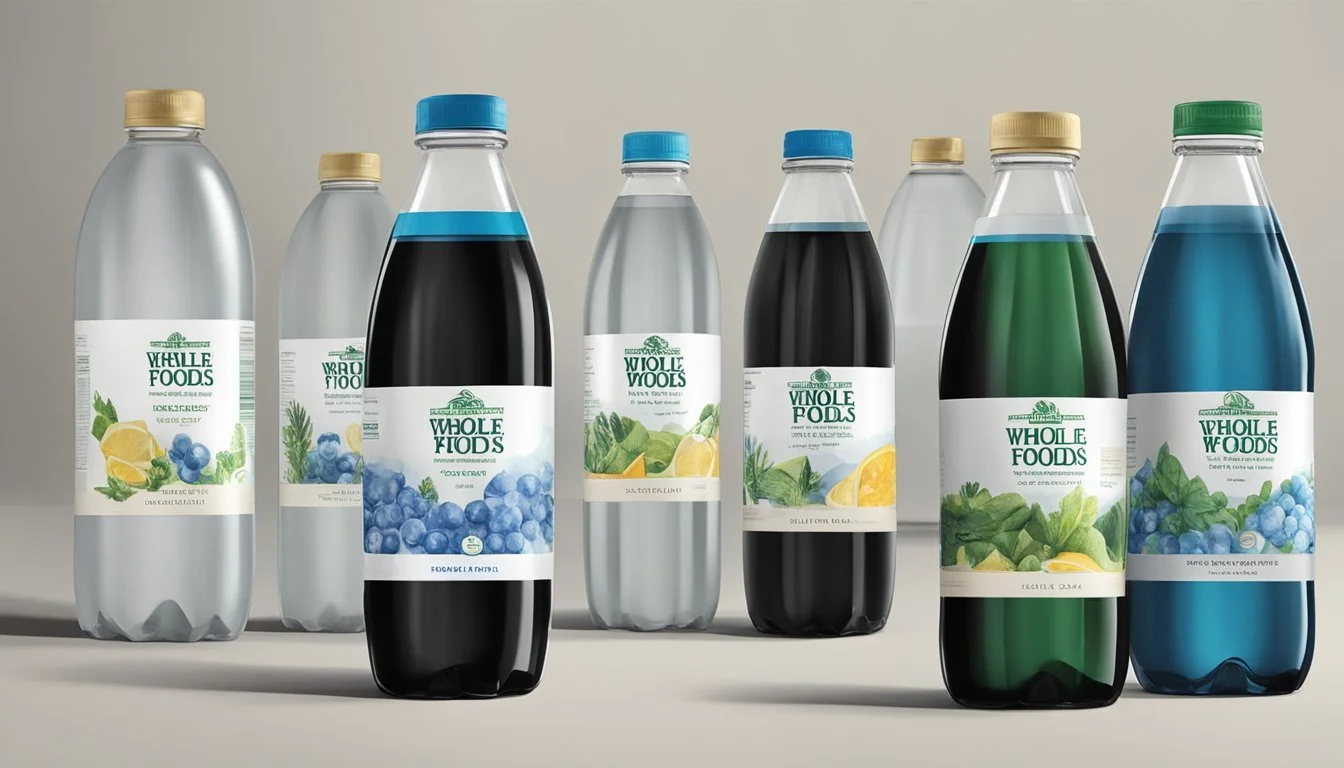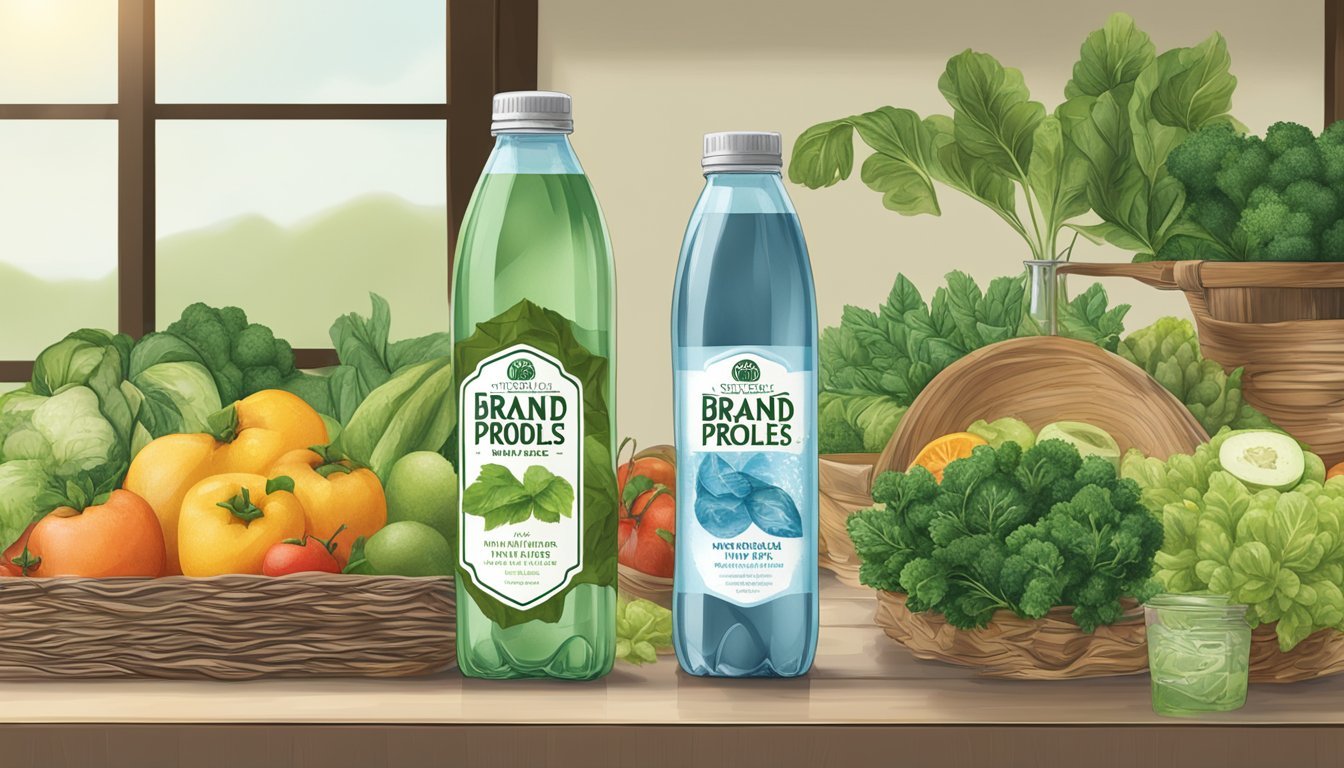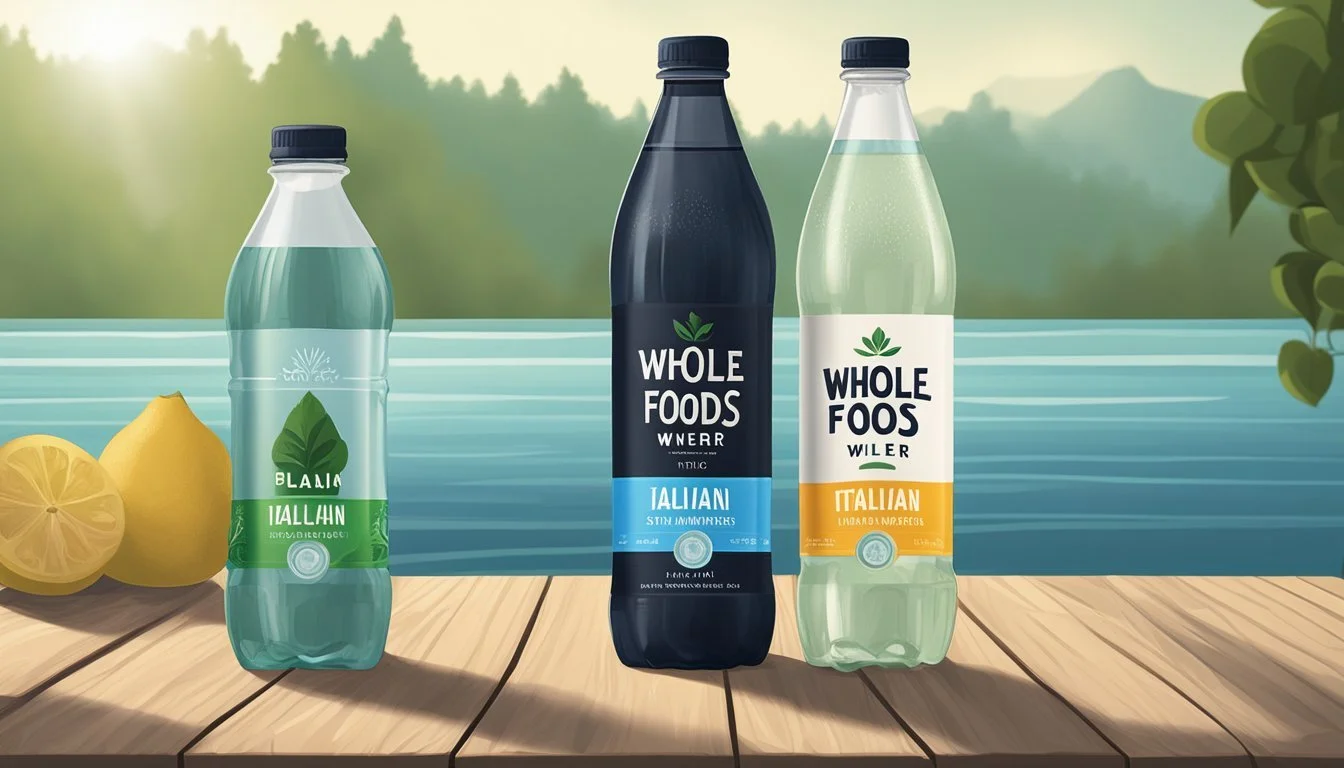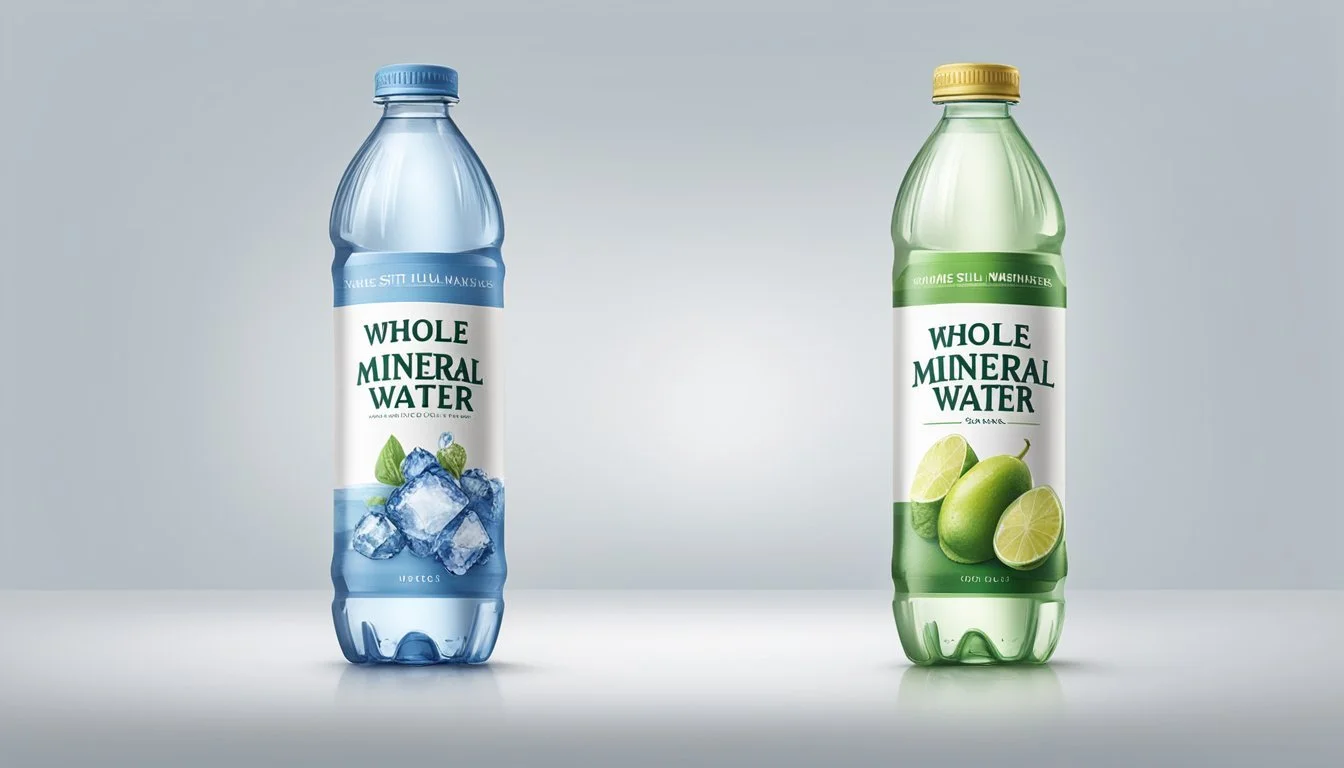Whole Foods Italian Still Mineral Water vs. Blk
A Comparative Analysis
When it comes to choosing bottled water, both Whole Foods Italian Still Mineral Water and Blk offer unique benefits. Whole Foods Italian Still Mineral Water is known for its purity and health benefits, with a reputation for high-quality sourcing from renowned regions in Italy. Blk, on the other hand, stands out due to its distinct black color, which comes from the fulvic trace minerals, promising added electrolytes and antioxidants.
Italian mineral water from Whole Foods is favored for its clean, refreshing taste and the brand's commitment to sustainability. Sourced from the La Galvanina Spa in Rimini, Italy, it carries a legacy of trust and quality. Conversely, Blk water provides an unconventional experience with added minerals that could appeal to those looking for a functional beverage beyond mere hydration.
Ultimately, the choice between Whole Foods Italian Still Mineral Water and Blk depends on individual preferences and specific health goals. Fans of a crisp, traditional taste may lean towards Whole Foods' offering, while those curious about alternative health benefits might find Blk's unique composition more appealing.
Understanding Bottled Water
Bottled water comes in various forms, each with unique properties based on its source and extraction methods. The processing and regulatory standards applied to bottled water ensure its purity and quality.
Types of Bottled Water
Spring Water: Derived from natural springs, this type retains the minerals found at the source. It is often bottled at the spring without any major treatment.
Mineral Water: Contains minerals such as calcium, magnesium, and sodium, sourced from mineral springs. It is recognized for its health benefits.
Sparkling Water: Carbonated naturally or artificially, giving it effervescence. It can come from natural springs or be infused with carbon dioxide.
Alkaline Water: Known for its higher pH level, this water claims to neutralize acid in the body. It often undergoes ionization to achieve its properties.
Sourcing and Extraction
Sources: Bottled water can originate from a variety of sources, including natural springs, wells, and municipal supplies.
Natural Springs: Spring and mineral waters are typically extracted from natural springs, maintaining the mineral profile of the source.
Extraction Methods: Ensuring minimal environmental disruption, modern extraction methods include sustainable practices. This can involve limiting extraction volumes and protecting surrounding ecosystems.
Sustainability: Eco-friendly practices in sourcing aim to reduce the environmental footprint. Companies may use recycled materials and energy-efficient extraction techniques.
Bottling Processes
Purity Testing: Bottled waters undergo stringent testing for contaminants to maintain high purity levels. This includes tests for microbes, heavy metals, and chemical residues.
Packaging: Water is bottled in a variety of materials such as PET and glass bottles. Glass bottles are often preferred for premium waters despite being heavier and more fragile.
Processes: The bottling process includes filtration, UV treatment, and ozonation to ensure safety and quality.
Eco-friendly Options: Increasingly, companies are adopting eco-friendly packaging solutions to reduce plastic waste. Options include biodegradable materials and bottles made from recycled plastics.
Regulations and Standards
Regulatory Bodies: In the United States, the FDA oversees bottled water standards, while the EPA regulates tap water. Both ensure safe consumption levels.
Standards: Mineral and spring waters sold across international markets must meet strict regulations for mineral content and purity. This includes both bottled and out of public water supplies.
Compliance: Companies must comply with local and international regulations regarding bottled water. This includes testing and documentation for contaminants and mineral content.
Labeling: Bottled water labels must accurately reflect the contents. This includes the source of the water and any treatments it has undergone.
Brand Profiles
The brands in question, Whole Foods Italian Still Mineral Water and Blk Water, offer unique qualities that cater to different consumer preferences. This section explores the key attributes of both brands to help you make an informed choice.
Whole Foods Italian Still Mineral Water
Whole Foods Italian Still Mineral Water is sourced from the Sibillini Mountains in Italy. Known for its clean and refreshing qualities, it is a popular choice for those who appreciate a subtle mineral taste in their water. Each bottle provides a balanced mineral profile, which can aid in bodily functions and wellness.
Key Attributes:
Source: Sibillini Mountains, Italy
Flavor: Subtle mineral taste
Mineral Content: High; includes essential minerals like calcium and magnesium
pH Balance: Neutral
Availability: Whole Foods stores and online
Fans of this water appreciate its smooth taste and health benefits, making it a staple in many households.
Blk Water Analysis
Blk Water stands out due to its unique appearance and composition. Infused with fulvic minerals, this water has a dark black color which is strikingly different from typical bottled waters. The minerals used are said to improve nutrient absorption and promote overall health.
Key Attributes:
Color: Black
Infusions: Fulvic minerals
Health Benefits: Claims of improved nutrient absorption
pH Balance: Alkaline
Availability: Various grocery stores and online
This alkaline water offers a distinctive option for those seeking something beyond traditional clear bottled waters and is marketed for its unique health benefits and striking appearance.
Properties of Water Brands
Whole Foods Italian Still Mineral Water and Blk water have distinct properties that make each of them unique and valuable. This section highlights key aspects like pH levels, mineral content, and taste to help you decide which is better suited to your needs.
pH Levels and Alkalinity
The pH level of water determines whether it is acidic, neutral, or alkaline. Whole Foods Italian Still Mineral Water tends to hover around a neutral pH, slightly acidic at about 5. This makes it refreshing for some but may not meet the needs of those seeking alkaline hydration.
Blk water, on the other hand, is known for its alkaline properties, typically having a pH of around 8-9. This higher pH can neutralize acidity in the body, making Blk a popular choice for those seeking balance and replenishment.
Mineral Content Breakdown
Mineral content is crucial for bodily functions and overall health. Whole Foods Italian Still Mineral Water is rich in minerals like calcium, magnesium, and potassium sourced from natural springs in Italy. These minerals contribute to hydration and various biological processes.
Blk water contains fulvic minerals, offering a unique combination of trace minerals absorbed from plant-based sources. It is marketed for its potential health benefits and distinct mineral profile, catering to those looking for a supplement-like water option.
Mineral Whole Foods Blk Calcium High Moderate Magnesium Moderate Moderate Potassium Moderate Low Fulvic Acid None High
Taste and Texture Profiles
Taste and texture can significantly affect your preference for bottled water. Whole Foods Italian Still Mineral Water is known for its clean, crisp taste with a smooth texture. Its natural mineral content offers a refreshing and neutral flavor, suitable for daily consumption.
Blk water has a distinctly different taste and appearance due to its fulvic minerals, which impart a slightly earthy flavor. Its dark color may be off-putting to some, but others find its unique taste appealing. The texture is smooth but has an underlying richness due to its mineral content.
Both waters cater to different preferences. Whole Foods offers a traditional, refreshing experience, while Blk provides a novel, mineral-rich option.
Health and Hydration Benefits
Whole Foods Italian Still Mineral Water and Blk water offer various health advantages and hydration properties. These benefits can affect hydration, mineral intake, and dietary choices to support bodily functions and overall well-being.
Hydration and Body Function
Proper hydration is essential for maintaining bodily functions. Both Whole Foods Italian Still Mineral Water and Blk water contribute to hydration, aiding in digestion, blood pressure regulation, and overall bodily functions.
Hydration impacts muscle function, nerve function, and electrolyte balance. Whole Foods Italian Still Mineral Water provides hydration with a low mineral content, making it suitable for those on low-sodium diets. Blk water, enriched with fulvic acid, enhances hydration by providing additional electrolytes that support the body's fluid balance.
Minerals and Health
Minerals are crucial for maintaining health. Whole Foods Italian Still Mineral Water is a source of essential minerals such as calcium, magnesium, and silica.
Calcium supports bone health, while magnesium aids muscle function and nerve function. Silica contributes to connective tissue health. On the other hand, Blk water provides fulvic acid, which aids nutrient absorption and detoxification, supporting overall health.
While the mineral content in Whole Foods Italian Still Mineral Water is beneficial for bone and cellular health, Blk water's fulvic acid offers unique health benefits by improving the bioavailability of nutrients.
Dietary Considerations
For those on specific diets, the choice of bottled water can be important. Whole Foods Italian Still Mineral Water has a low-sodium content, making it ideal for low-sodium diets.
Additionally, the natural mineral content supports daily dietary needs without contributing to excess sodium intake. Blk water, with its fulvic acid, adds no extra calories, sugars, or artificial additives, aligning well with various dietary preferences, including vegan and keto diets.
Choosing between the two depends on individual dietary needs and preferences, ensuring hydration and health benefits align with personal health goals.
Environmental and Sustainability Concerns
Both Whole Foods Italian Still Mineral Water and Blk place a strong emphasis on environmental and sustainability concerns. They focus on responsible water extraction and effective bottle production and recycling practices.
Water Source Conservation
Whole Foods sources its Italian Still Mineral Water from natural springs located in regions such as the Sibillini Mountains, Dolomites, and Tuscany. The company ensures that the extraction process does not harm these pristine environments.
Sustainability practices are in place to manage and preserve the natural springs, ensuring a consistent and ecologically friendly water supply. These sustainability practices include limiting extraction rates and monitoring the ecological impact on the surrounding areas.
Bottle Production and Recycling
Whole Foods uses glass bottles for its Italian Still Mineral Water. Glass is eco-friendly as it is fully recyclable and reduces plastic waste. The production of glass bottles entails higher carbon emissions initially, but the long-term recyclability offsets these impacts.
In contrast, Blk uses PET plastic bottles which are also recyclable. The company encourages recycling by providing information on how consumers can recycle their bottles efficiently. Both brands strive for eco-friendly packaging but differ in their material choice and long-term environmental impact.
Pricing and Availability
Whole Foods Italian Still Mineral Water and Blk water differ significantly in terms of price points and where they can be purchased. Each brand offers various sizes and has unique distribution channels that impact their overall availability and cost to consumers.
Price Comparison
Whole Foods Italian Still Mineral Water is typically sold at a premium price given its branding and mineral content. A standard 33.8 fl oz (1 L) bottle can cost around $1.49 to $2.29.
Blk water tends to have a higher price. A standard 16.9 fl oz (500ml) bottle usually ranges from $1.99 to $2.99.
The price varies depending on promotions and regional pricing differences.
Retail Availability
Whole Foods Italian Still Mineral Water is primarily available at Whole Foods Market stores across the United States. It can also be found on the Whole Foods online store.
Blk water is more widely distributed and can be found in various grocery stores, health food stores, and specialty shops. It's also widely available online through retailers like Amazon and the Blk water website.
Both brands are generally easy to find both in physical stores and online, making them accessible to a broad audience.
Consumer Preferences and Trends
Consumer preferences in bottled water have shifted towards products that offer both quality and taste. Whole Foods Italian Still Mineral Water and Blk Water attract different segments due to their unique characteristics.
Whole Foods Italian Still Mineral Water is favored for its light taste and natural mineral content. Sourced from Italy, many consumers appreciate its purity and health benefits.
Blk Water stands out due to its distinctive black color, resulting from fulvic trace minerals. Consumers intrigued by its unique appearance also enjoy its rich mineral content and slightly alkaline nature.
Price is a decisive factor. Whole Foods Italian Still Mineral Water is often seen as a budget-friendly option without compromising quality.
Taste and overall quality play crucial roles in consumer choices. Some prefer the crisp taste of Whole Foods water, while others are drawn to the notable taste profile of Blk.
Consumer trends indicate a preference for sustainability, affecting buying decisions. Whole Foods markets its commitment to eco-friendly practices, while Blk's innovative product appeals to those seeking novelty in their water choices.
More About Whole Foods Italian Still Mineral Water
Acqua Pana vs Whole Foods Italian Still Mineral water: Which Bottled Water is Better?
Antipodes vs Whole Foods Italian Still Mineral water: Which Bottled Water is Better?
Aqua Carpatica vs Whole Foods Italian Still Mineral water: Which Bottled Water is Better?
Aquafina vs Whole Foods Italian Still Mineral water: Which Bottled Water is Better?
Arrowhead vs Whole Foods Italian Still Mineral water: Which Bottled Water is Better?
Bai vs Whole Foods Italian Still Mineral water: Which Bottled Water is Better?
Boxed Water vs Whole Foods Italian Still Mineral water: Which Bottled Water is Better?
Castle Rock vs Whole Foods Italian Still Mineral water: Which Bottled Water is Better?
Core Hydration vs Whole Foods Italian Still Mineral water: Which Bottled Water is Better?
Deer Park vs Whole Foods Italian Still Mineral water: Which Bottled Water is Better?
Erewhon vs Whole Foods Italian Still Mineral water: Which Bottled Water is Better?
Essentia vs Whole Foods Italian Still Mineral water: Which Bottled Water is Better?
Eternal vs Whole Foods Italian Still Mineral water: Which Bottled Water is Better?
Ethos vs Whole Foods Italian Still Mineral water: Which Bottled Water is Better?
Evian vs Whole Foods Italian Still Mineral water: Which Bottled Water is Better?
Fiji vs Whole Foods Italian Still Mineral water: Which Bottled Water is Better?
Flow vs Whole Foods Italian Still Mineral water: Which Bottled Water is Better?
Hawaii Volcanic vs Whole Foods Italian Still Mineral water: Which Bottled Water is Better?
Hawaiian Springs vs Whole Foods Italian Still Mineral water: Which Bottled Water is Better?
Ice Mountain vs Whole Foods Italian Still Mineral water: Which Bottled Water is Better?
Icelandic Glacial vs Whole Foods Italian Still Mineral water: Which Bottled Water is Better?
Just Water vs Whole Foods Italian Still Mineral water: Which Bottled Water is Better?
LIFEWTR vs Whole Foods Italian Still Mineral water: Which Bottled Water is Better?
Liquid Death vs Whole Foods Italian Still Mineral water: Which Bottled Water is Better?
Mananalu vs Whole Foods Italian Still Mineral water: Which Bottled Water is Better?
Nestle Pure Life vs Whole Foods Italian Still Mineral water: Which Bottled Water is Better?
Origin vs Whole Foods Italian Still Mineral water: Which Bottled Water is Better?
Ozarka vs Whole Foods Italian Still Mineral water: Which Bottled Water is Better?
Path vs Whole Foods Italian Still Mineral water: Which Bottled Water is Better?
Penta vs Whole Foods Italian Still Mineral water: Which Bottled Water is Better?
Perrier vs Whole Foods Italian Still Mineral water: Which Bottled Water is Better?
Poland Spring vs Whole Foods Italian Still Mineral water: Which Bottled Water is Better?
Purely Sedona vs Whole Foods Italian Still Mineral water: Which Bottled Water is Better?
San Pellegrino vs Whole Foods Italian Still Mineral water: Which Bottled Water is Better?
Smartwater vs Whole Foods Italian Still Mineral water: Which Bottled Water is Better?
Solan de Cabras vs Whole Foods Italian Still Mineral water: Which Bottled Water is Better?
Starkey vs Whole Foods Italian Still Mineral water: Which Bottled Water is Better?
Tahoe vs Whole Foods Italian Still Mineral water: Which Bottled Water is Better?
Topo Chico vs Whole Foods Italian Still Mineral water: Which Bottled Water is Better?
Tru Alka vs Whole Foods Italian Still Mineral water: Which Bottled Water is Better?
Volvic vs Whole Foods Italian Still Mineral water: Which Bottled Water is Better?
Voss vs Whole Foods Italian Still Mineral water: Which Bottled Water is Better?
Waiakea vs Whole Foods Italian Still Mineral water: Which Bottled Water is Better?
Whole Foods Italian Still Mineral water vs 1907water: Which Bottled Water is Better?
Whole Foods Italian Still Mineral water vs 7-Select: Which Bottled Water is Better?
Whole Foods Italian Still Mineral water vs Action: Which Bottled Water is Better?
Whole Foods Italian Still Mineral water vs Alkaline88: Which Bottled Water is Better?
Whole Foods Italian Still Mineral water vs Augi: Which Bottled Water is Better?
Whole Foods Italian Still Mineral water vs Big Chill: Which Bottled Water is Better?
Whole Foods Italian Still Mineral water vs Big Win: Which Bottled Water is Better?
Whole Foods Italian Still Mineral water vs BodyArmor: Which Bottled Water is Better?
Whole Foods Italian Still Mineral water vs Cascade Mountain: Which Bottled Water is Better?
Whole Foods Italian Still Mineral water vs CBD Living: Which Bottled Water is Better?
Whole Foods Italian Still Mineral water vs Cirro: Which Bottled Water is Better?
Whole Foods Italian Still Mineral water vs Crystal Geyser: Which Bottled Water is Better?
Whole Foods Italian Still Mineral water vs Crystal Lake: Which Bottled Water is Better?
Whole Foods Italian Still Mineral water vs Dasani: Which Bottled Water is Better?
Whole Foods Italian Still Mineral water vs Defy: Which Bottled Water is Better?
Whole Foods Italian Still Mineral water vs Essence pH10: Which Bottled Water is Better?
Whole Foods Italian Still Mineral water vs HFactor: Which Bottled Water is Better?
Whole Foods Italian Still Mineral water vs Kirkland Signature: Which Bottled Water is Better?
Whole Foods Italian Still Mineral water vs Kroger: Which Bottled Water is Better?
Whole Foods Italian Still Mineral water vs Open Water: Which Bottled Water is Better?
Whole Foods Italian Still Mineral water vs Ophora: Which Bottled Water is Better?
Whole Foods Italian Still Mineral water vs Proud Source: Which Bottled Water is Better?
Whole Foods Italian Still Mineral water vs Pure Life: Which Bottled Water is Better?
Whole Foods Italian Still Mineral water vs Ramona: Which Bottled Water is Better?
Whole Foods Italian Still Mineral water vs Refreshe: Which Bottled Water is Better?
Whole Foods Italian Still Mineral water vs Richard's Rainwater: Which Bottled Water is Better?
Whole Foods Italian Still Mineral water vs Simple Truth: Which Bottled Water is Better?
Whole Foods Italian Still Mineral water vs Skyra: Which Bottled Water is Better?
Whole Foods Italian Still Mineral water vs Talking Rain AQA: Which Bottled Water is Better?
Whole Foods Italian Still Mineral water vs The Well: Which Bottled Water is Better?
Whole Foods Italian Still Mineral water vs Weird Water: Which Bottled Water is Better?
Whole Foods Italian Still Mineral water vs Whole Foods 365: Which Bottled Water is Better?
Whole Foods Italian Still Mineral water vs Zenwtr: Which Bottled Water is Better?
Zephyrhills vs Whole Foods Italian Still Mineral water: Which Bottled Water is Better?









